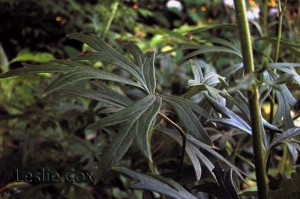Agastache rugosa
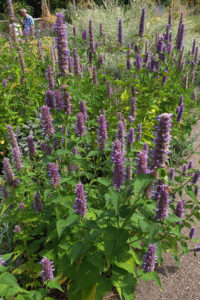 Agastache rugosa
Agastache rugosa
(ag-ak-STAK-ee roo-GO-sah)
syn. Lophanthus rugosus
Family: Lamiaceae
Common name: Korean mint; purple giant hyssop
Zone: 5 – 9
Height: 24 – 36 in (60 – 90 cm)
Spread: 24 in (60 cm)
Aspect: full sun; partial shade
Soil: moist; well-draining
Water: regular
Description: An herbaceous perennial with an erect habit. Oval, closely-toothed, medium green leaves are slightly hairy on their underside. Short spikes of lavender-blue flowers appear from mid-summer through to early fall. Small seeds are black.
Special Notes: Native to Korea, Japan, China and Vietnam. Leaves have a strong mint and liquorice scent when rubbed. Ornamental and medicinal plant used for teas, seasoning meats and in Eastern medicine. Perfect dried flower. Attracts bees and butterflies. Relatively few pests and disease problems but watch for powdery mildew. Propagate by seed, by cuttings in early spring or in summer, or by division in early spring or autumn.
In our Zone 7a garden: I have placed a few of these plants in my front bed where they must compete with the roots of my mature Aesculus hippocastanum (European horse chestnut) and Acer saccharinum (silver maple) trees. The soil is not stellar in this area of my garden and I have a hard time getting enough water to the plants. The two trees are famous for sucking all of the benefits out of the soil. Having said that, Agastache rugosa is one plant species that survives in my garden under these tough conditions, despite what the reference sources stipulate are its growing needs. Of course, it is not as lush as if it were provided fertile soil and adequate water but by planting more plants close together I can achieve roughly the same effect as from one plant alone.
Posted on March 13, 2013; updated on August 5, 2024
Agastache foeniculum ‘Golden Jubilee’
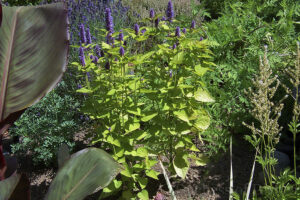 Agastache foeniculum ‘Golden Jubilee’
Agastache foeniculum ‘Golden Jubilee’
(ag-ah-STAK-ee foe-NIK-yew-lum)
Family: Lamiaceae
Common name: golden anise hyssop
Zone: 5 – 9
Height: 24 – 36 in (60 – 90cm)
Spread: 18 – 24 in (45 – 60cm)
Aspect: full sun; partial shade
Soil: average; well-draining
Water: moderate
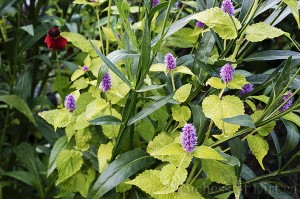 Description: An herbaceous perennial with an upright, clump-forming habit. Oval, closely-toothed, golden leaves are slightly hairy on their underside. Short spikes of lavender-purple flowers appear from mid-summer through to early autumn. Small seeds are black.
Description: An herbaceous perennial with an upright, clump-forming habit. Oval, closely-toothed, golden leaves are slightly hairy on their underside. Short spikes of lavender-purple flowers appear from mid-summer through to early autumn. Small seeds are black.
Special Notes: Very first golden-leaved agastache bred by K. Sahin Zaden in Holland. Named in honour of Queen Elizabeth II celebrating her 50th year reign – her Golden Jubilee. Leaves have a pleasing anise scent when rubbed. Great for tea. Seeds may be used in baking. Perfect dried flower. Attracts bees and butterflies. Relatively few pests and disease problems but watch for powdery mildew. Propagate by seed, by cuttings in early spring or in summer, or by division in early spring or autumn. Will self-sow.
Posted on April 28, 2013; updated on August 5, 2024
Aconitum napellus f. album
 Aconitum napellus f. album
Aconitum napellus f. album
(ak-on-EYE-tum ne-PELL-us f. AL-bum)
Family: Rununculaceae
Common name: aconite; monkshood; wolf’s bane; friar’s cap
Zone: 5 – 8
Height: 4 – 5 ft (1.2 – 1.5 m)
Spread: 2 ft (0.6 m)
Aspect: full sun; partial shade
Soil: moist; fertile; well-draining
Water: regular
Description: An herbaceous perennial with an upright growth habit. Large rounded, dark green leaves are deeply lobed. Panicles of hooded white flowers appear mid-summer through autumn. Flowers are composed of 5 petals with the upper one bulging upward to form a hood-like shape.
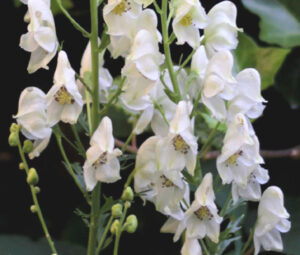 Special Notes: Native to Europe and temperate regions of Asia. May need staking in exposed position. Few pests or diseases. Used in ancient times until quite recently for deliberate poisoning. Propagation is by fresh seed; division in spring or autumn.
Special Notes: Native to Europe and temperate regions of Asia. May need staking in exposed position. Few pests or diseases. Used in ancient times until quite recently for deliberate poisoning. Propagation is by fresh seed; division in spring or autumn.
Caution: All parts of the plant are toxic if ingested. Wear gloves when handling. Sap may cause skin irritation on some people. It can also be absorbed through the pores, if left on exposed skin. Thoroughly wash affected area if you come into contact with the sap. Also wash thoroughly should you be handling any part of this plant without protective gloves.
Posted on December 17, 2012;
updated on August 5, 2024
Acanthus spinosus
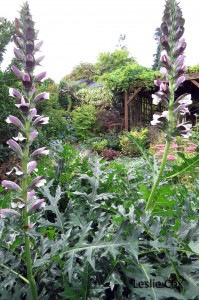 Acanthus spinosus Family: Acanthaceae
Acanthus spinosus Family: Acanthaceae
(ah-KAN-thus speen-OH-sus)
Common name: spiny bear’s breeches
Zone: 6 – 9
Height: 4 – 5 ft (1.2 – 1.5m)
Spread: 3 ft (0.9m)
Aspect: full sun; partial shade
Soil: fertile; moist; well-draining
Water: regular
Description: An herbaceous perennial with a clump-forming habit. Deeply lobed, shiny, deep green leaves have soft spines along edge. Thirty-inch tall (75 cm) spikes of white hooded flowers flushed with a touch of pink and clasped in deep purple calyces gradually open up along the spike starting in mid-summer through into autumn.
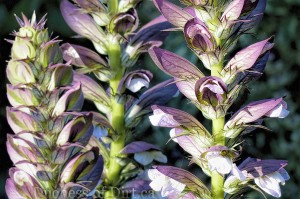 Special Notes: Native to the southeast region of Europe, eastern Mediterranean area, western Turkey and northeast region of Italy. Big, bold, beautiful plant. Attracts bees. May want some shade from hot afternoon sun. Be forewarned: plant this species where you would like it to remain because if any bit of root is left behind when plant is moved, it will come again. Propagate by fresh seed; divide in spring or autumn.
Special Notes: Native to the southeast region of Europe, eastern Mediterranean area, western Turkey and northeast region of Italy. Big, bold, beautiful plant. Attracts bees. May want some shade from hot afternoon sun. Be forewarned: plant this species where you would like it to remain because if any bit of root is left behind when plant is moved, it will come again. Propagate by fresh seed; divide in spring or autumn.
In our Zone 7a garden: This species of acanthus performs very well in our garden although its newly emerging leaves will sport a bright orange fungus growth if we have a cold, damp spring. This fungus does not do any damage to the leaves and disappears once the temperatures warm up and the weather dries out a bit.
Acanthus spinosus attracts much attention from our visitors to the garden in the summer for its spectacular display of botanical grandeur. And the bumblebees absolutely love the flowers, madly pushing with their back legs to get their fat, chubby bodies right inside the hooded blossoms.
Warning: Acanthus spinosus is a vigorous grower, quickly expanding its territory in the garden bed. Every three years John has to bring his acanthus back within its boundaries by removing the external stems in an attempt to keep the plant under control.
It is one of those plants that if you leave a piece of root behind, it will quickly reestablish itself. For this reason, as well as the effort needed to keep it restrained in the garden, we do not recommend this plant to the hobby gardener.
Great Plant Pick 2006
Posted on April 14, 2014; updated on August 5, 2024
Acanthus mollis
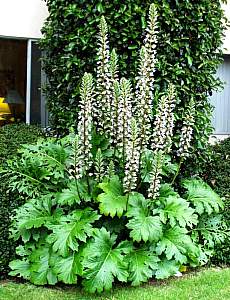 Acanthus mollis Family: Acanthaceae
Acanthus mollis Family: Acanthaceae
(ah-KAN-thus MAWL-iss)
Common name: common bear’s breeches
Zone: 7 – 10
Height: 4 – 5 ft (1.2 – 1.5m)
Spread: 3 ft (0.9m)
Aspect: full sun; partial shade
Soil: fertile; moist; well-draining
Water: regular
Description: An herbaceous perennial with a clump-forming habit. Shiny, deep green leaves are jagged-edged. Three-foot tall (90 cm) spikes of white hooded flowers clasped in deep purple calyces gradually open up along the spike starting in mid-summer through into autumn.
Special Notes: Native to the southwest region of Europe and northwest Africa. Big, bold, beautiful plant. Attracts bees. May want some shade from hot afternoon sun. In hot climates, this particular species is likely to go dormant in summer but re-appear when the weather cools. Be forewarned: plant this species where you would like it to remain because if any bit of root is left behind when plant is moved, it will come again. Propagate by fresh seed; divide in spring or autumn.
In our Zone 7a garden: Acanthus mollis is a surprisingly difficult plant to grow in spite of its given common name. According to Larry Hodgson in his book, Perennials for Every Purpose (Rodale 2000) this particular acanthus only grows well in a few specific areas. We must be in one of those tougher regions on the outskirts of its favoured growing range as the one solitary Acanthus mollis plant that continues to survive in our garden never gets above about three feet (90 cm) tall year after year and has never flowered.
Update: This plant is no longer in our garden.
Posted on April 14, 2013; updated on August 5, 2024
